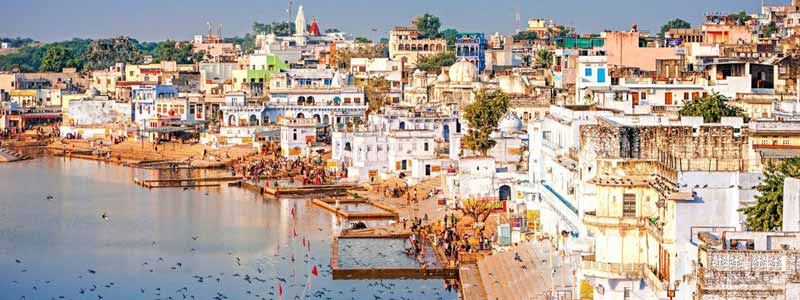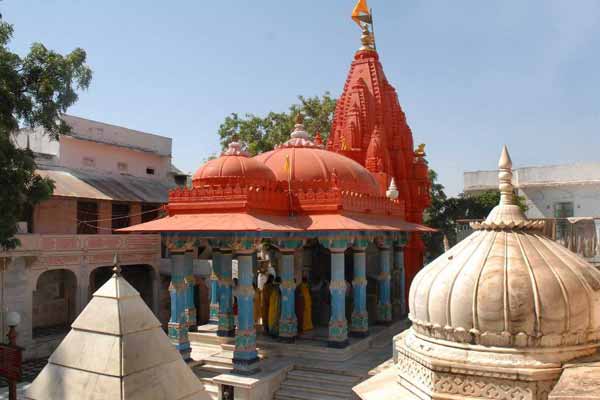Top 7 Attractions In Pushkar Located within the district of Ajmer, in the lands of the Indian state of Rajasthan, TirthRaj Pushkar commonly known as Pushkar is an aesthetic city among the hills. Pushkar is a popular city because of its best places to visit in Pushkar. While planning a trip to Pushkar, one can find Top Tourist attractions in Pushkar. Most of the best tourist places in Pushkar are temples, as that is related to the history of Pushkar.
Famous places to visit in Pushkar are so entirely dependent on the weather and the time you choose to visit. Both of these factors depend on the fact, in which month you are visiting. If you are preparing a list of places to visit in Pushkar, then you have to add the Brahma Temple to your list. Most of us have heard Pushkar being a religious place, and a family holiday spot, but recent times prove it wrong. One can find places to visit in Pushkar for couples.
All the temples and ghats that today we see in Pushkar are from the 18th Century. Pushkar is famous for the Camel Fair, which is popularly known as Pushkar Camel Fair. The city also holds the only temple of Lord Brahma. It is a traditional and sacred city, and holds esteem by the Hindu religion, particularly in Shaktism.
Pushkar is situated in the center-east part of Rajasthan, to the western side of the Aravalli range of hills. Being near to some of the oldest geological structures in India, it is said to be settled in ancient times. The city of Pushkar is mentioned in the Ramayana, the Mahabharata, and the Puranas bringing out its significance in the Hinduism religion Pushkar Tour Packages.

Pushkar Lake
Pushkar Lake is said to be as old as creation itself because of the legend that it was created when a lotus fell from the hands of Lord Brahma, the creator deity. Hindu mythology describes the five lakes: Man Sarovar, Bindu Sarovar, Narayan Sarovar, Pampa Sarovar, and Pushkar Sarovar. The holiest of all of them is believed to be Pushkar Lake. Devotees believe that bathing in the lake on Kartik Poornima (during the Pushkar Fair) will atone for sins and cure all skin problems. This artificial lake was created by building a dam hidden away in the Aravalli range, surrounded by a desert and hills.
The lake contains 52 bathing ghats (steps that go into the water), and it is said that the water at each ghat has unique healing potential. Over 500 temples may be seen along the shores of Pushkar Lake, indicating that it is a well-liked pilgrimage site.
Things To Do At Pushkar Lake – Bathing, View Sunset & Sunrise, Explore various Ghats, Relaxing
Brahma Temple
The Jagatpita Brahma Mandir, close to the well-known Pushkar Lake, honours Lord Brahma, the Hindu God of Creation. Although the existing structure comes from the 14th century, the original construction is roughly 2000 years old. Pushkar is home to more than 500 temples, many of which are quite old, but the Brahma temple is the most prominent one. After coming to earth to carry out a yajna, according to mythology, Brahma built his temple here. Hindu philosopher Adi Shankara renovated the temple in the eighth century. However, Maharaja Jawat Raj of Ratlam is credited with repairing and making minor modifications to the existing structure. The Lord Brahma and Gayatri, his second wife, are honoured in the temple’s.
Marble and stone stabs are used to construct the temple. The temple has a striking hamsa (bird) theme, and its scarlet pinnacle (shikhara) may be spotted from a distance. A celebration honouring Brahma is held in the town on Kartik Poornima during Pushkar Festival. After taking a bath and purifying oneself in the famous Pushkar Lake, devout pilgrims go to the temple. One of the top 10 most spiritual locations in the world, the Brahma Temple is regarded as one of the five holiest pilgrimage sites for Hindus.
Things To Do At Brahma Temple – Worship to Lord Brahma, Visit Pushkar Lake and Shopping at the nearby market
Savitri temple
This temple is situated on a mountain just behind the Brahma temple and is dedicated to Lord Brahma’s first wife, Goddess Savitri. One may get a panoramic view of the lake, nearby temples, and dunes while acclimating to the long flight of steps leading to the temple. Savitri cursed Brahma for marrying Gayatri while beginning his yagna at Pushkar; that’s why there is only one Brahma Temple in Pushkar.
The goddesses Savitri and Gayatri’s idols are kept at the temple. You can go through Ratnagiri Hill to reach the temple as the route goes through many hills. This trip is particularly crucial from a religious perspective since it is seen as a form of atonement for our sins.
Varaha Temple
Varaha Temple is one of the largest and ancient temples in Pushkar and very well-known for its uniqueness. Dedicated to Varaha, a boar which is an incarnation of Lord Vishnu. It is an important pilgrimage site for all devotees of Lord Vishnu. Constructed around the 12th century, it was destroyed by Aurangzeb and later reconstructed by Raja Sawai Jai Singh II in the year 1727. At the internal sanctum, you will find an idol of Lord Vishnu and a wild boar that makes it a great site to behold in Pushkar. Overall a unique site and one of the famous tourist attraction in Pushkar that you have to visit at least once.
Things To Do At Varaha Temple – Photography, Visit an idol of Lord Vishnu and Sightseeing
Rangji Temple
Famous for its magnificent architectural design, Rangji Temple is a perfect blend of Mughal, Rajput and South Indian style of architecture. Constructed by Seth Puran Mal Ganeriwal in 1823, the temple complex is very famous for its marvellous artwork that soothes your eyes. Dedicated to an incarnation of Lord Vishnu known as Rangji, it is one of the best places to visit in Pushkar, where devotees of Lord Vishnu gather on some special occasion.
Things To Do At Rangji Temple – Worship, Sightseeing and Take a glimpse of marvellous artwork
Man Mahal
Situated alongside the Pushkar Lake, Man Mahal is the biggest royal residence in Pushkar. It was constructed by Raja Man Singh of Amber as a retreat centre. Now it becomes a popular tourist spot to visit in Pushkar. Later it was converted into a tourist bungalow from where one can take the panoramic view of Pushkar Lake that is truly admirable.
Further, the architectural design of this Mahal gives you a glimpse of traditional Rajasthani and a little bit of Mughal style of architecture. The palace offers a very comfortable stay to its guest and also arrange some adventure activity tour on guest demand like Camel Safari and Desert Camping. Apart from all these things, it is a perfect site for photography too as the location offers many mesmerising views of surrounding nature. Moreover, one of the Top 7 Attractions In Pushkar that should not be missed.
Things To Do At Man Mahal – Enjoy Sightseeing, Photography, Take the panoramic view of Pushkar Lake
Rose Garden
Pushkar is surprisingly well-known for its rose growing. The Rajasthan Rose Garden is the name given to Rose Garden. The farmers in this area raise a lot of different varieties of roses, which are exported all over the world. Various coloured, fragrant, and stunning red roses cover acres of farmland, enticing one to relax and spend some beautiful time. Travel to these popular Pushkar tourism destinations for an unforgettable trip with your loved ones Top 7 Attractions In Pushkar.
Activities: Take a seat, unwind, and rest while taking in the fascinating fragrance of roses.
